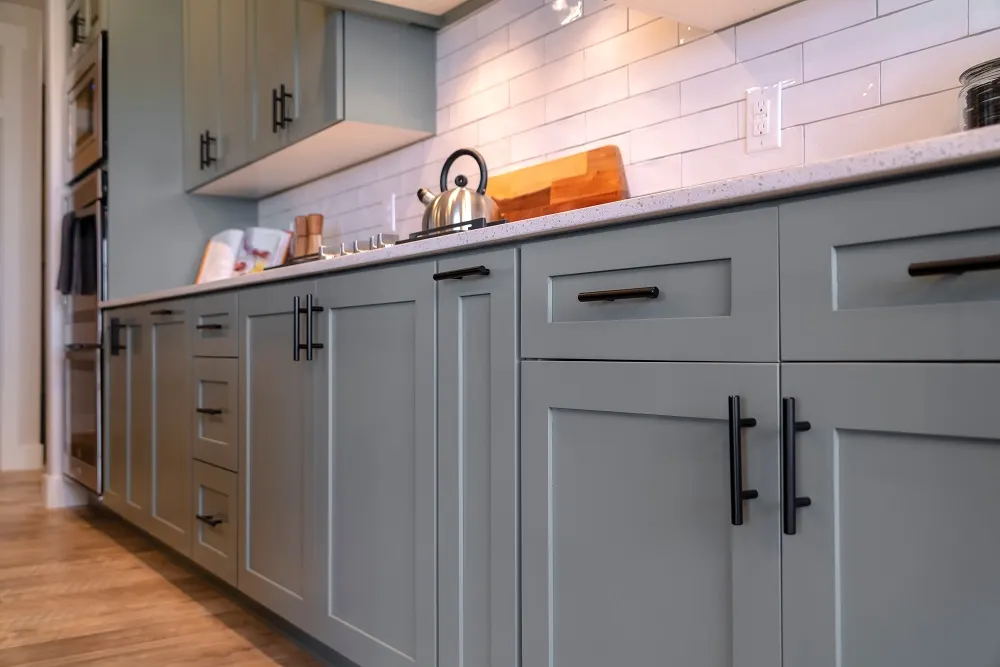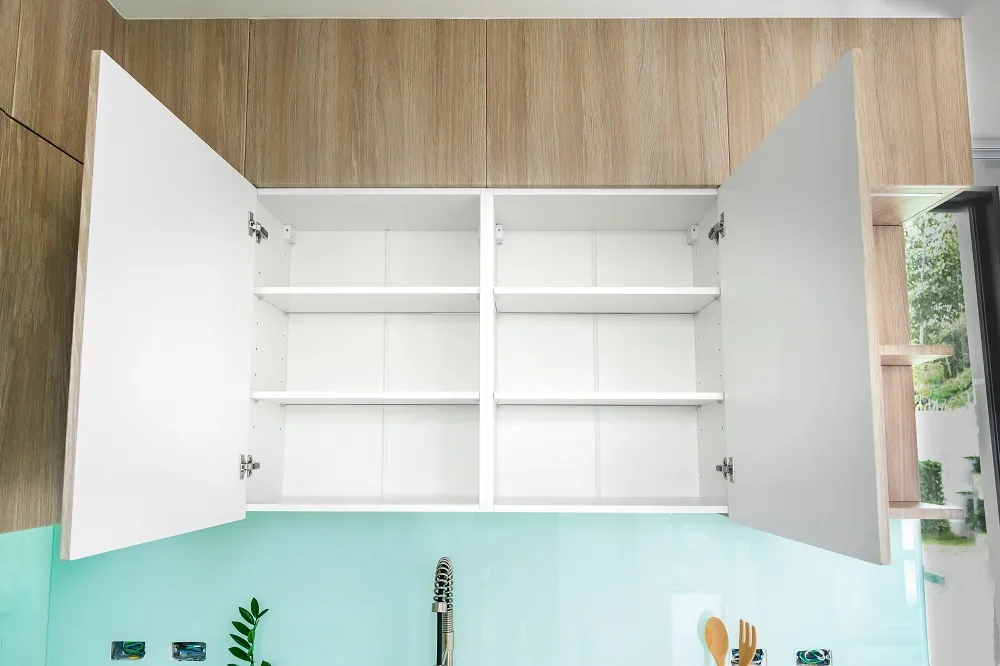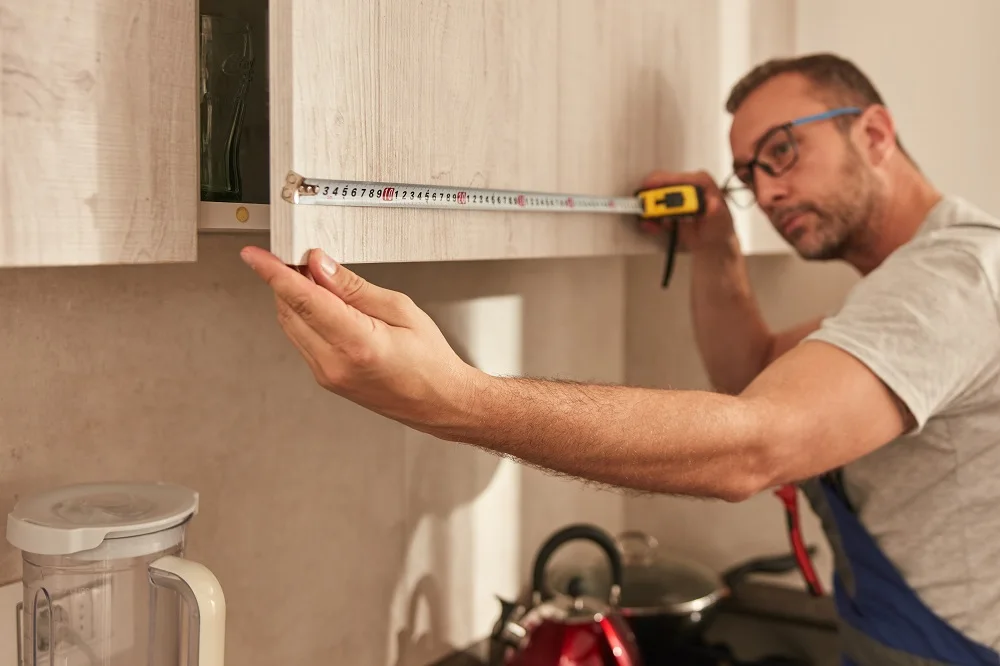
Before You Try a Kitchen with Shelves Instead of Cabinets, Read This
Are open shelves in the kitchen out of style? Learn the reality of living with open shelving and explore cabinet refacing as a practical alternative.











Choosing between thermofoil and melamine shouldn’t feel like a guessing game. Both materials look sharp and perform well, but they handle daily kitchen life in different ways.
As a Chicagoland cabinet refacing company that works with these materials every day, we’ve seen what holds up through steamy summers and dry winters. Here’s what really separates thermofoil from melamine, so you can pick what fits your home best.
Thermofoil is a 3D-laminate pressed onto medium-density fiberboard (MDF) using heat and vacuum pressure. The result is a smooth, wrapped surface that looks like painted wood without brush marks or texture lines. Because it’s fully sealed, it stands up well to moisture and cleans easily, which makes it a favorite for busy households that want a polished finish.
Melamine starts as a resin-coated paper fused to a particleboard or MDF base under high pressure. The finish is tough, scratch-resistant, and steady under daily wear. You’ll see the edge seams where panels meet, which give it a more natural, straightforward look. Homeowners who want durability with less shine often lean toward melamine for its no-fuss appearance.
Here’s how the two options perform in the areas that matter most: durability, cost, and long-term kitchen performance.
Each material excels in different situations, which is why many homeowners choose based on specific kitchen zones and family needs rather than picking one for everything. Your kitchen's layout and how your family uses the space often determine which material performs best.
Both materials have their place. Many homeowners combine them — using thermofoil where the look matters most and melamine in workhorse zones that see daily wear. Think about how your kitchen actually functions, and you’ll know which one makes more sense.
Thermofoil can peel or bubble when exposed to steady heat above 150°F, which happens more often than most people realize. This risk shows up near ovens, dishwashers, and coffeemakers where heat collects every day. Melamine performs better under heat and rarely warps or discolors, even after years beside hot appliances.
Winner for heat exposure: Melamine holds its structure and finish near heat sources, while thermofoil needs careful placement away from appliances.
Thermofoil’s sealed surface keeps water out and protects the MDF core from swelling. Melamine also resists moisture but can swell at edges if the surface coating is damaged. In humid climates like Chicago’s, thermofoil offers stronger defense against water intrusion.
Winner for moisture protection: Thermofoil leads in this category thanks to its fully sealed surface, which prevents leaks at vulnerable seams.
Melamine’s rigid surface stands up to scratches and scuffs better than thermofoil, an advantage for families who cook often. Thermofoil can show wear in high-use zones where doors and drawers get constant handling. Neither material dents easily, though melamine edges may chip if struck by heavy cookware.
For homes with kids or pets, melamine’s durability usually outweighs thermofoil’s flawless look. It hides everyday wear more effectively over time.

Upfront cost matters when planning your kitchen update, but long-term performance and potential replacement costs tell the complete financial story. Both materials deliver value compared to replacing cabinets, though in different ways.
Thermofoil generally costs about 15–25% higher than melamine because it requires vacuum press technology and specialized machinery. Still, both options cost far less than replacing cabinets completely, often saving homeowners thousands on a kitchen remodel. Installation costs are nearly identical since both involve refacing existing cabinet boxes with skilled craftsmanship rather than full replacement.
Both materials demand little upkeep compared to painted cabinets that need frequent touch-ups. Thermofoil may require professional repair if heat exposure causes peeling, an issue melamine users rarely face. Melamine’s edge banding can be replaced quickly and at low cost, making small fixes simple and affordable even after years of use.
Both materials appeal to buyers looking for updated kitchens without signs of major renovation disruption. Chicago buyers particularly appreciate moisture-resistant materials, given our climate challenges. Seamless thermofoil may photograph better for listings with its painted-cabinet appearance, while melamine's durability holds up better during showings and inspections.
According to the 2025 Cost vs. Value Report, minor kitchen updates deliver 113% cost recouped at resale in the Midwest.
Melamine typically offers stronger long-term value for families planning to stay put since it holds up under daily wear. Thermofoil, on the other hand, can give a home a fresh, market-ready edge when resale timing matters.
Both thermofoil and melamine come in wide color palettes and modern finishes that refresh an outdated kitchen instantly. Each brings a different look and texture, helping homeowners match their taste and the home’s style.
Thermofoil offers a sleek, uniform surface that mimics painted cabinets without brush marks or uneven texture. Melamine provides a light grain and visible edge lines that give it a more natural, straightforward character. Some homeowners love thermofoil for its crisp, flawless finish, while others prefer melamine’s durable, family-friendly texture.
Both materials come in hundreds of colors, including whites, grays, wood grains, and bold accent colors that match current kitchen design trends. Thermofoil offers slightly more glossy finish options, while melamine excels in matte textures that hide fingerprints. Both materials stay on-trend with contemporary kitchen styles popular in Chicagoland homes, from classic whites to modern navy blues.
Thermofoil keeps its clean look for years, but can develop a slight yellow tint near windows with strong sunlight over time. Melamine resists fading better, yet may show light wear where doors and drawers are handled most. Both last far longer than painted finishes, often staying fresh for 10–15 years with regular care.
Your final choice depends on what you value more — thermofoil’s continuous, seamless surface or melamine’s durable, textured finish that hides signs of daily use.
Thermofoil's smooth surface makes daily cleaning simple for busy families. The sealed finish resists most kitchen messes without special products or techniques.
Daily cleaning and maintenance:
Thermofoil cabinets stay looking new with minimal effort thanks to the material's non-porous surface and high durability. For more detailed guidance, check our complete thermofoil care guide.

Melamine’s dense, protective layer stands up to daily messes and needs only basic cleaning supplies. It’s a time-saver for busy households that want durable, low-maintenance cabinets.
Daily cleaning and maintenance:
Melamine’s tough, scratch-resistant surface makes it ideal for families with kids or busy kitchens. It stands up to real life and keeps its appearance even after years of use.
The best material depends on your kitchen's specific conditions, not general preferences or trends. Your appliance placement, family lifestyle, and how long you plan to stay in your home all factor into which material delivers better results.
When thermofoil delivers better long-term performance:
Thermofoil excels when your kitchen layout naturally protects it from its main weakness — heat exposure — while taking advantage of its superior moisture resistance. For professional installation that maximizes material performance, learn why hiring experienced refacers matters for long-term results.

Both thermofoil and melamine bring a modern, high-performing finish to cabinet refacing projects, but each shines under different conditions. Thermofoil is ideal for decorative zones and moisture-prone areas away from heat, while melamine stands up to busy, high-heat spaces that see daily use.
Kitchen Cabinet Guys specializes in helping Chicagoland homeowners choose the right materials based on their kitchen's layout, appliance placement, and family needs. Our team works with both materials daily and uses advanced vacuum press technology to ensure professional results. Contact us today to schedule a free consultation where we'll assess your kitchen and recommend the best material strategy for your cabinet refacing project.
Both materials can be painted with proper preparation, though it requires specialized primers designed for non-porous surfaces. The sealed surfaces resist paint adhesion, making professional refinishing advisable if you want results that last. Choosing the right color initially saves hassle since both materials hold their color well for 10-15 years without fading.
With proper care, both materials last about 10–15 years, far longer than painted cabinets that often need touch-ups every few years. Thermofoil may need repair sooner if installed near heat, while melamine’s lifespan depends on how well its edges are protected in high-impact areas. Installed correctly, both outperform most painted and laminate alternatives.
Absolutely. Both are low-VOC and meet today’s indoor air safety standards. They’re free of formaldehyde emissions after installation, making them healthier than some older finishes. Melamine’s extra-tough surface also resists the scratches and dings that come with family life.
Each performs better than wood or paint during our city’s seasonal swings. Thermofoil’s sealed surface keeps moisture out during humid summers, while melamine’s stable structure resists cracking when the air dries in winter. Both adapt well to Chicago’s conditions, keeping your cabinets looking consistent year-round.

Stop scrolling and start planning. Get expert, one-on-one advice during a free consultation and move forward with confidence.
Call Us Now: (800) 809-7197 or
Get a Free Estimate